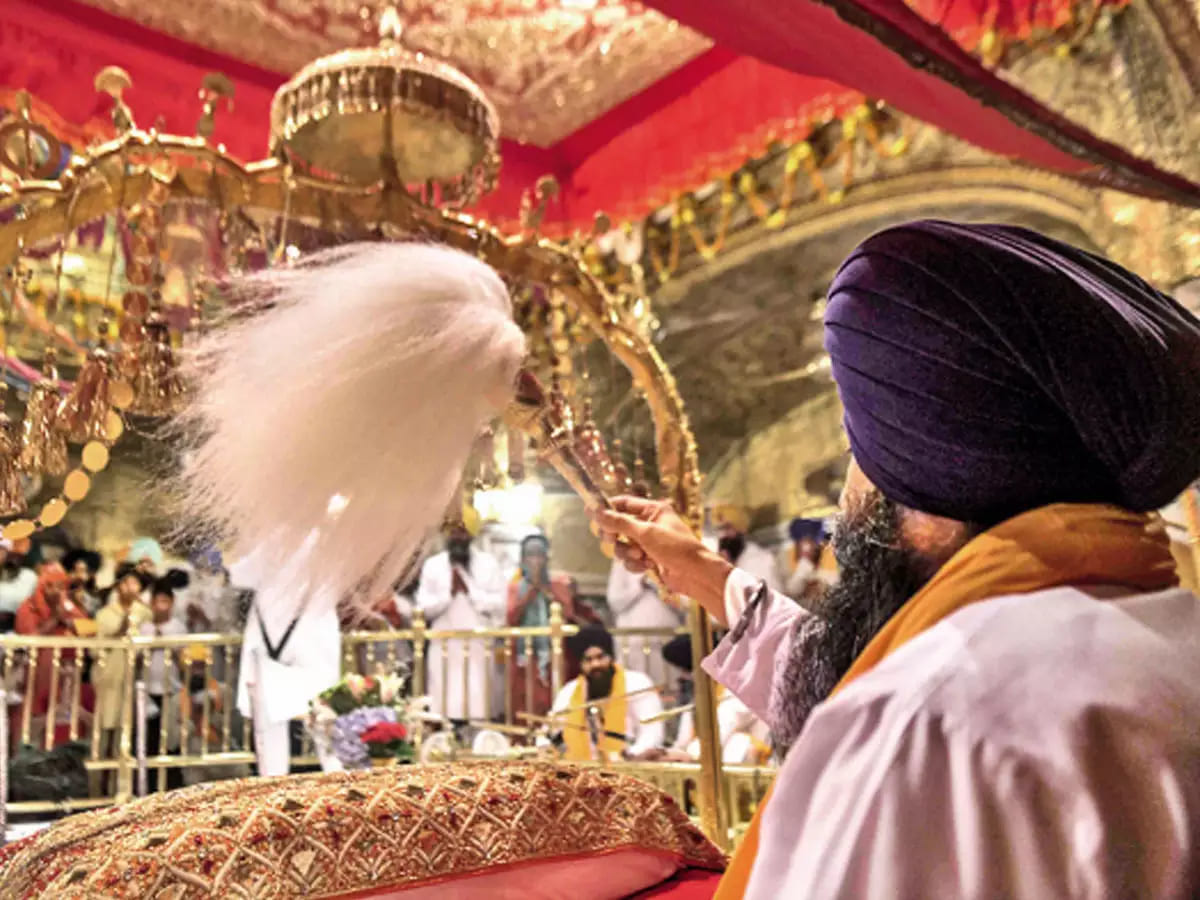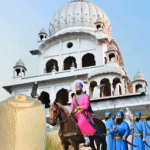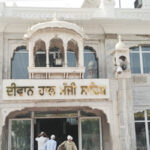In Sikh temples worldwide, known as Gurdwaras, one will consistently find a Chaur Sahib, a ceremonial whisk, placed near the revered Sri Guru Granth Sahib Ji, the eternal Guru and holy scripture of Sikhism.
The Chaur Sahib
The Chaur Sahib holds a esteemed position, always accompanying Guru Granth Sahib. Its typically positioned or placed near the Manji, Peera, or Palki Sahib, where the Sri Guru Granth Sahib Ji is enshrined during the day within the Darbar Sahib (Main Hall) of the Gurdwara.
Its primary purpose is to fan the Sri Guru Granth Sahib Ji, symbolizing deep reverence and respect for the sacred scriptures. A dedicated Sevadar (volunteer) gracefully waves the Chaur Sahib above the Guru Sahib, demonstrating utmost respect and devotion. In the worship space of the Gurdwara Sahib, any Sikh, regardless of age or gender, may engage in Chaur Sahib seva whenever the scripture is open for Prakash.
The Chaur Sahib is an obligatory item to be present wherever the Guru Granth Sahib Ji is positioned. In contemporary times, the Chaur Sahib comes in various sizes and is typically crafted with Nylon hair, attached to a simple or ornate wooden or metallic handle. The fan, usually in a pristine white color, represents purity and truthfulness, fundamental principles in Sikh philosophy. The handle, whether simple or adorned with intricate designs, carvings, or precious materials, varies in appearance across different artifacts. However, regardless of its physical diversity, every Chaur Sahib serves a unified purpose—to be utilized as a tool of reverence and devotion towards the eternal Guru, the Guru Granth Sahib Ji.
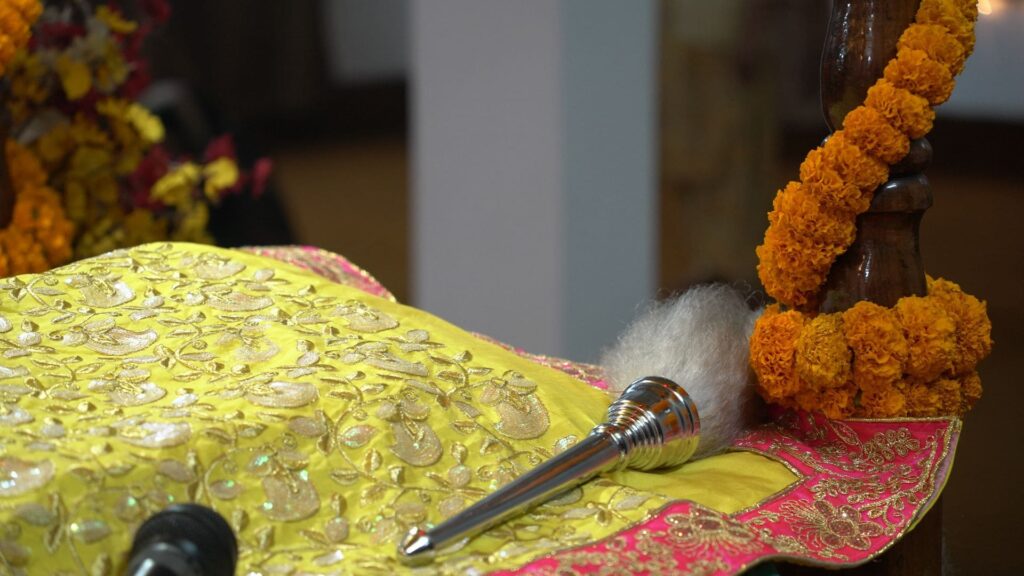
This ceremonial tool is utilized during all spiritual pujas and artis, signifying its auspicious nature. It is believed to enhance the positive environment and is employed to show respect to deities and holy scriptures.During the Ardas ceremony, the Chaur Sahib is waved over Guru Granth Sahib Ji, either by the Granthi Sahib or another individual, as a sign of reverence and respect.
Particularly favored for Sri Guru Granth Sahib Ji’s Sanchi Sahib Parkash, the Chaur Sahib remains an integral element in the display of veneration and devotion within the Sikh faith.
Chaur Sahib seva is considered a highly honorable service for the Guru, and many Sikhs engage in this service at their local Gurdwara or at home if they have the Sri Guru Granth Sahib there. This act of seva reflects deep respect for the Guru’s message (Gurbani) and embodies humility (Nimrata) towards the Guru’s teachings. Additionally, while waving the Chaur Sahib, the Sevadar silently recites the Gurmantar, Waheguru. This means that during this seva, individuals not only perform service but also engage in Simran, a meditative remembrance of the Divine. Both Simran and Seva are foundational principles in Sikhism.
Originally, during the time of the first ten Gurus, this tradition had practical origins. In Punjab, it was customary for younger family members to fan their elders during hot weather to create a cool breeze and keep flies away. The chaur was initially made of peacock feathers, wood, or canvas, creating a refreshing airflow when waved. The Chaur Sahib is waved to create a cooling breeze, symbolizing the humility and service-oriented values that Sikhs strive to embody.
This tradition was extended to the Gurus and is now observed with the Sri Guru Granth Sahib. It was also a practice associated with kings and royalty. Although the need for moving air has diminished with modern comforts like air conditioning, the essence of “seva” has become even more crucial. Sikhs consider the Sri Guru Granth Sahib as a “living Guru,” and they honor it with the same traditions that were accorded to human Gurus in ancient times.
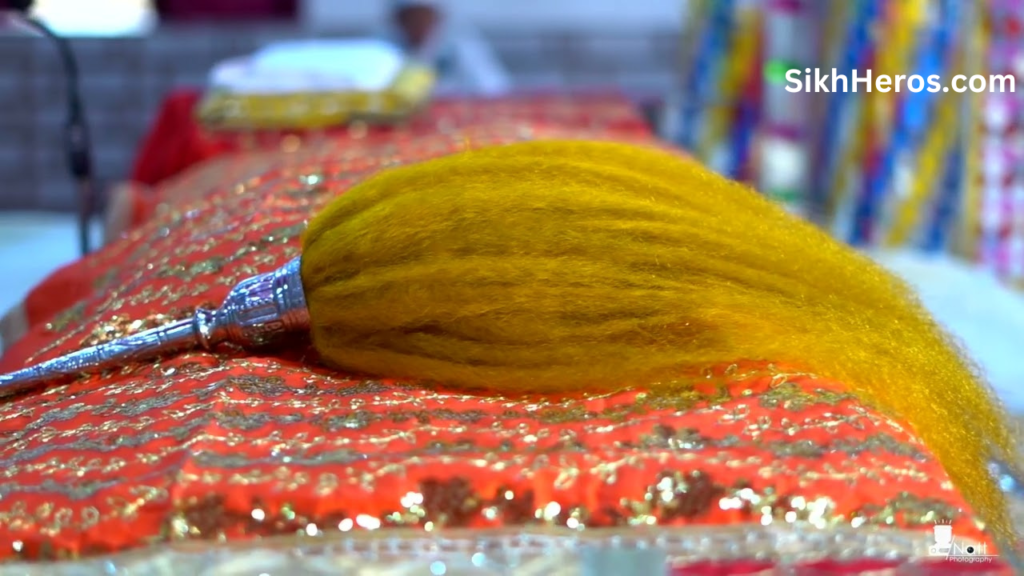
Chaur Seva is just one of these essential traditions that Sikhs practice to show utmost respect and regard for the teachings in Gurbani. It’s important to note that Sikhs don’t ‘worship’ the Guru Granth, as worship is reserved only for the ‘One Almighty God,’ the Creator of everything. During the time of the first ten Gurus, the Sangat (congregation) and Sevadar (volunteers) who traveled from far distances sought to be close to the Gurus, listening to their wisdom (Shabad). They would sit near the Guru, taking turns to perform Chaur Seva to be as close to their Guru as possible.
Ideal for the Prakash ceremony of Sri Guru Granth Sahib Ji at Sanchi Sahib.
Specifications:
Handle Length: 8 inches (20 cm)
Hair Length: Approximately 12 inches (30 cm)
Hair Quality: Nylon Hair
Hair Color: White
Material: Wood (Brown)
Weight: Approximately 100 to 200 g
Country/Region of Manufacture: Punjab, IndiaThe Chaur Sahib holds a special place in Sikh religious practices, playing a significant role in various aspects. The act of performing Chaur Sahib should be carried out with both hands by a devoted Gursikh. Prior to engaging in this service, one should ensure that their hands are cleansed. It is essential to conduct this seva with utmost reverence and love for Guru Sahib, avoiding casual or hasty gestures, as it is not merely a task to be completed but a meaningful expression of devotion.
In Gurdwaras:
The Chaur Sahib is a crucial element during Sikh religious services in Gurdwaras, the Sikh temples. When the sacred scripture, Guru Granth Sahib Ji, is placed on a throne-like structure, a volunteer waves the Chaur Sahib over it as a gesture of respect. This ritual symbolizes the high regard for the Guru Granth Sahib Ji. Waving the Chaur Sahib also serves a practical purpose by keeping the scripture free from dust, emphasizing the concept of ‘seva’ or selfless service.
In Processions:
During Sikh religious processions like Nagar Kirtans, where devotional hymns are sung while parading through streets, the Chaur Sahib plays a vital role. The Guru Granth Sahib Ji is carried on a decorated float, and the Chaur Sahib is continually waved over it, emphasizing the deep respect for the eternal Guru.
Personal Devotion:
Beyond Gurdwaras and processions, the Chaur Sahib finds a place in individual devotion. Some Sikhs use a smaller version of the Chaur Sahib in their homes as part of their personal worship. This practice allows devotees to incorporate the profound symbolism and significance of the Chaur Sahib into their daily religious routine.
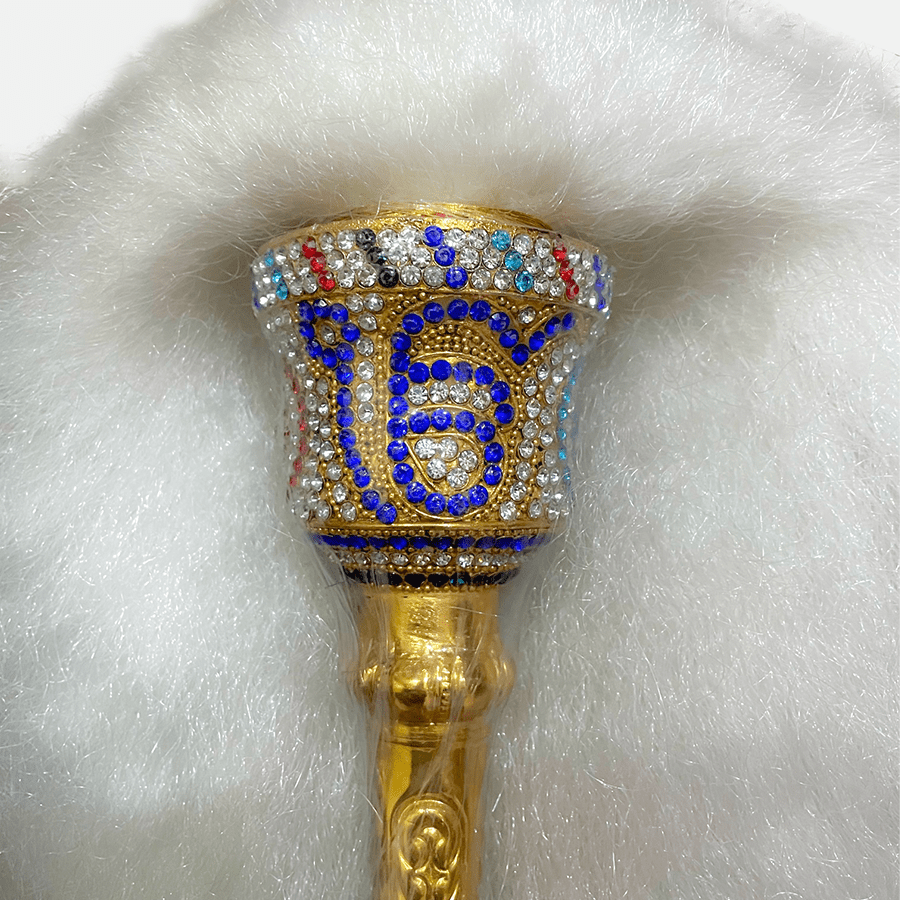
Question: Why do we perform the Chaur Sahib ceremony on the Guru Granth Sahib? Why is the Guru Granth Sahib Ji placed on a bed, and why is there a canopy?
The Chaur Sahib ceremony is a way of expressing our respect and regard for the Holy Scripture, which is considered a divine gift. In ancient times, kings held great power and received maximum respect and honor. However, Guru Nanak emphasized that true kings are those who love God and help others do the same. They rule over people’s hearts. While political kings are temporary and their authority ends with death, the Gurus were often called “The True King.” The Guru Granth Sahib, our true earthly emperor, guides us in loving our fellow human beings and the one True God. It embodies the spirit of all Sikh Gurus and other holy men whose hymns are included in the Holy Granth.
In the Gurdwara, the Guru Granth Sahib is treated with the same regal paraphernalia as ancient rulers. It is installed on a throne (Manji Sahib) surrounded by supporting pillows. A canopy (Chanani) is provided above the scripture, akin to what was placed over a king’s head during court sessions. During the Diwan (session), a person with a Chaur is always in attendance on the scripture installed respectfully in the hall. To maintain due respect, the holy scripture is carried to another room when the hall is to be cleaned or when the session concludes for the day. Before bringing the Guru Granth Sahib into the hall, everything is set properly—a symbolic court of the Guru.
In ancient courts, the ruler’s throne provided a level of comfort not afforded to courtiers, being higher and sometimes even in a loft. The lavish canopy protected the ruler from birds, falling objects, or the sun, and on warm days, only the ruler was fanned.
The entire ceremony becomes clearer when envisioning a modern courtroom where everything is set and made ready before a judge enters. For Sikhs, the Guru Granth Sahib is the Emperor of Emperors, hence the use of these ancient ceremonial trappings.
A fan made of yak hair, sometimes of peacock feathers, was waved over living Gurus, and now this practice continues over the Granth Sahib Ji, signifying the Royal Authority invested in it by Guru Gobind Singh Ji. No one in the Gurdwara is seated above the SGGS ( Siri Guru Granth Sahib Ji), emphasizing its elevated status. At the Harmandir Sahib, there is an opening on the second floor in the Shish Mahall area, ensuring that no one may stand or walk above the SGGS. Nowadays its made with steel handle as well and Nylon fur.
Why have the chaur sahib when we have electric fans that can provide a healthy flow of air and keep any flies away?
The Chaur Sahib holds deep symbolic and spiritual significance in Sikhism. While electric fans may offer practical benefits, the Chaur Sahib is not merely about providing airflow. It represents humility, selfless service (seva), and respect for the Guru Granth Sahib Ji. The act of waving the Chaur Sahib is a ritualistic expression of devotion and reverence, transcending its practical utility.
Is this not a ritual that is just pure outwardly behavior?
The use of the Chaur Sahib goes beyond mere outward behavior. While it may have a visual element, it is a meaningful ritual deeply rooted in Sikh philosophy. Waving the Chaur Sahib symbolizes humility, service, and the acknowledgment of the sacredness of the Guru Granth Sahib Ji. It’s a practice that aims to cultivate an inner connection and spiritual mindfulness, rather than being purely superficial.
If it is not a ritual, then what is it?
The use of the Chaur Sahib is indeed a ritual, but one with profound spiritual significance. It is a symbolic gesture of respect, devotion, and service to the Guru Granth Sahib Ji. Beyond its visual aspect, the ritual is a means for Sikhs to express their commitment to the teachings of Sikhism, emphasizing values like humility and selfless service.
What happens if you don’t do so?
The response is simple: nothing. There are no repercussions for not doing so because the Guru is immortal and doesn’t require fanning. Additionally, the Guru does not specifically encourage this action. Instead, Sikhs perform Chaur Sahib (fanning) as a voluntary expression of reverence and respect for the Holy scripture.
